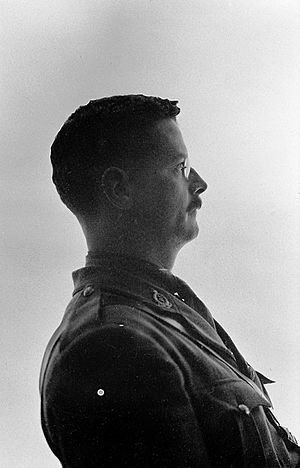Gordon Morgan Holmes facts for kids
Quick facts for kids
Gordon Morgan Holmes
|
|
|---|---|
 |
|
| Born | 22 February 1876 Louth, Ireland
|
| Died | 29 December 1965 (aged 89) Farnham, England
|
| Alma mater | Trinity College, Dublin |
| Spouse(s) | Rosalie Jobson |
| Awards | Fellow of the Royal Society |
Sir Gordon Morgan Holmes (born February 22, 1876 – died December 29, 1965) was a famous doctor from Ireland and England. He was a neurologist, which means he studied the brain and nervous system. He is well known for his important discoveries about the cerebellum (the part of your brain that helps with balance and movement) and the visual cortex (the part that helps you see).
Contents
Early Life and Learning
Gordon Holmes grew up in County Louth, Ireland. His father was a farmer. He went to school at Dundalk Educational Institution and then studied medicine at Trinity College, Dublin. He finished his medical degree in 1897 when he was 21 years old. Even though he had a small problem with reading (dyslexia) when he was young, he was a very bright student.
After medical school, Holmes worked in a mental hospital for a short time. He then traveled to New Zealand as a ship's doctor. When he returned, he went to Germany to study neurology even more. He spent two and a half years learning about the brain in Berlin and Frankfurt.
A Doctor's Journey
In 1906, Holmes started working at the National Hospital for Nervous Diseases in London. This was a very important place for studying the brain.
Wartime Discoveries
When First World War started, Sir Gordon became a special brain doctor for the British army. He worked in a field hospital in France. This gave him a unique chance to study how brain injuries affected soldiers. He saw how damage to different parts of the brain could change a person's balance, vision, or even bladder control.
While in France, he met Dr. Rosalie Jobson, who later became his wife. She was also a doctor and a great sportswoman. His observations during the war made him very interested in the cerebellum. This led to his famous talks in 1922, where he explained the symptoms of problems with the cerebellum.
Working with Other Scientists
Back in London, Holmes worked with other famous scientists. He teamed up with Henry Head in 1908. Together, they made important discoveries about how the brain's optic thalamus works with the cerebral cortex to help us feel and understand things. They were a good team because Head was full of ideas, while Holmes was very careful and always checked the facts.
Holmes also wanted adventure! He tried to join Captain Robert Falcon Scott's trip to the South Pole. But he hurt his leg, so he couldn't go. Instead, he used that time to get a higher medical degree.
Later Career and Honors
After the war, Holmes continued to work at the National Hospital. He was also a doctor at Moorfields Eye Hospital and Charing Cross Hospital. He was known as an amazing teacher of neurology. Many young doctors came to his weekly discussions at the hospital to learn from him.
He was also the editor of a medical journal called Brain for many years. He helped many young neurologists by carefully checking their writings and making them better.
Sir Gordon Morgan Holmes received many honors for his work:
- He was made a Companion of the Order of St Michael and St George (CMG) in 1917.
- He became a Commander of the Order of the British Empire (CBE) in 1919.
- He was chosen as a Fellow of the Royal Society in 1933, which is a very high honor for scientists.
- He was knighted in 1951, which means he was given the title "Sir."
Sir Gordon Morgan Holmes was a dedicated doctor and researcher who greatly advanced our understanding of the human brain.

